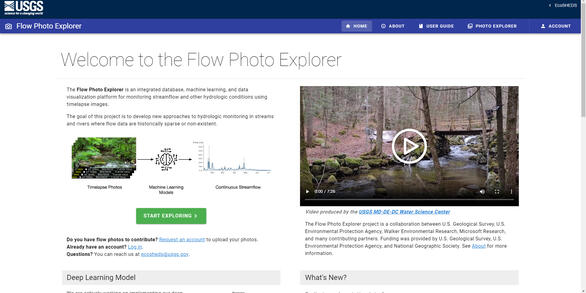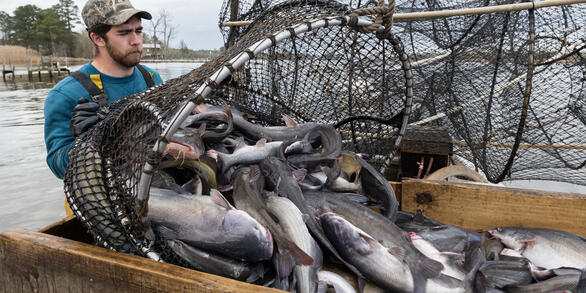Freshwater and Coastal Ecology
Freshwater and Coastal Ecology
At the Eastern Ecological Science Center (EESC), we strive to provide world-class science to inform natural resource decisions that preserve and enhance our quality of life.
Filter Total Items: 50
New studies reveal ecological importance of fine-scale groundwater connectivity for streams during drought
Stream ecosystems support vital resources that may be jeopardized by climate change and climate stressors such as drought.
Advancing the Environmental DNA Toolkit for Ecosystem Monitoring and Management
The emerging field of Environmental DNA (eDNA) analysis allows characterization of species presence and community biodiversity by identifying trace amounts of genetic material left behind as organisms move through their environments. EESC scientists have been using eDNA technologies to detect native and rare species and as community biomonitoring tools.
Observed monitoring data and predictive modelling help understand ongoing and future vulnerability of Chesapeake Bay watershed stream fish communities to climate and land-use change
Issue: The Chesapeake Bay Watershed (CBW) is experiencing effects of climate (warming temperatures and shifting precipitation patterns) and land-use/land-cover (LULC; transition from forest or agriculture to developed lands) change, and these trends are likely to continue under future scenarios of warming and population growth. Stream biodiversity may be vulnerable to ongoing and future climate...
Northeast Amphibian Research and Monitoring Initiative
The U.S. Geological Survey’s Eastern Ecological Science Center is home to the Northeast Amphibian Research and Monitoring Initiative (NEARMI), one of 7 ARMI regions across the United States. NEARMI works on public lands in thirteen states from Maine to Virginia, including many National Parks and National Wildlife Refuges.
Study reveals importance of groundwater for stability of freshwater fish populations and resilience to climate change
Issue: Climate change is warming streams and rivers of the Chesapeake Bay watershed, and this is a critical concern for fisheries management and conservation. To address this issue, the Chesapeake Bay Program (CBP) recently identified four actions: • address the threats of climate change in all aspects of the partnership’s work; • prioritize communities, working lands, and most vulnerable habitats...
Brook trout vulnerability to drought: eastern component of USGS national integrated ecohydrological research
There is a growing and urgent need to develop and implement innovative strategies to research, monitor, and manage freshwater resources as societal demands escalate simultaneously with climate-driven changes in water availability.
Assessing the habitat conditions to support freshwater fisheries in the Chesapeake Watershed
Issue: The Chesapeake Bay Program partners are striving to improve habitat conditions for recreational fisheries and other native fishes in the Bay and its watershed. While national fish habitat assessments have been conducted, resource managers need more local information to focus restoration and protection efforts in Chesapeake Bay watershed. Conducting the fish-habitat assessments are...
Eastern Ecological Science Center partnership with Atlantic States Marine Fisheries Commission
Collaboration between the world-class expertise of USGS scientists, the Atlantic States Marine Fisheries Commission’s Science Program, and state and federal fishery agencies demonstrates the power of partnerships to solve seemingly-insurmountable problems in sustainable and cooperative management of Atlantic coastal fisheries.
Time marches on, but do factors driving instream habitat and biology remain consistent?
Issue: Stream ecosystems are affected by a complex set of interacting terrestrial and aquatic stressors. With many streams experiencing degraded conditions that often correspond with increased anthropogenic activities, an important outcome of the Chesapeake Bay Program is to improve stream health. The USGS is conducting research to better understand the complex factors affecting stream health...
Use of Structured Decision Making to Optimize Salt Marsh Management Decisions at Northeastern National Wildlife Refuges
US Fish and Wildlife Service completed a regional assessment of salt marsh integrity (SMI) on 15 National Wildlife Refuges/Refuge Complexes in the northeastern US. Developed within a structured decision making (SDM) framework, the SMI assessment provides essential baseline data on salt marsh condition relative to regional management objectives. These data now provide the basis for applying the SDM...
The response of coastal wetlands to sea-level rise: Understanding how macroscale drivers influence local processes and feedbacks
The purpose of this work is to advance our understanding of how coastal wetland responses to SLR within the conterminous United States are likely to vary as a function of local, regional, and macroscale drivers, including climate. Based on our interactions with managers and decision makers, as well as our knowledge of the current state of the science, we propose to (a) conduct a national synoptic...
Virginia Coast Reserve Long Term Ecological Research VII
The highly protected Virginia Coast Reserve (VCR) is the largest undeveloped region along the Atlantic seaboard.The VCR is managed by the Nature Conservancy, and was designated a Man and the Biosphere Reserve in 1979, providing a unique environment for which to study coastal impacts of climate change on a variety of coastal ecosystems from barrier islands across back barrier lagoons, mudflats...
















